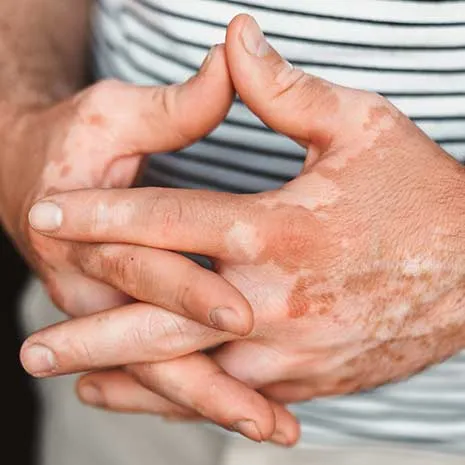Vitiligo on Hands and Feet: Causes and Treatment Options

Vitiligo on Hands and Feet: Causes and Treatment Options
- 7 August 2025
- 100

Why Is Vitiligo on Hands and Feet So Hard to Treat?
While vitiligo can affect any part of the body, the hands and feet—particularly the fingers, toes, knuckles, and heels—are among the most treatment-resistant areas. Several reasons explain this:
- Lower melanocyte density: Fewer pigment cells exist in these areas.
- Limited blood supply: These distal parts receive less circulation, which slows healing.
- Frequent mechanical trauma: Constant use and environmental exposure increase stress on the skin.
- Less sun exposure: Compared to the face, these areas receive less UV, which aids spontaneous repigmentation.
What Causes Vitiligo on the Hands and Feet?
While the exact cause of vitiligo is still unknown, it is considered a multifactorial condition involving autoimmune, genetic, and environmental factors.
Triggers Especially Relevant to the Extremities Include:
- Genetic predisposition
- Friction and trauma (frequent hand washing, barefoot walking)
- Chemical exposure (cleaners, soaps, industrial substances)
- Oxidative stress and immune system imbalance
- Vitamin D deficiency
These factors are often more intense on the hands and feet due to daily usage and environmental contact.
Treatment Options for Hand and Foot Vitiligo
Because these areas are less responsive, they require tailored, sometimes combined, treatment strategies.
1. NB-UVB Phototherapy
- The most widely used light therapy
- Special devices are designed to target hands and feet
- Often combined with topical treatments for better results
2. 308nm Excimer Laser
- Offers targeted light exposure
- Suitable for small patches
- Requires 2–3 sessions per week, often shows faster results than NB-UVB
3. Topical Treatments
- Tacrolimus or pimecrolimus (non-steroidal immunomodulators)
- Mid-potency corticosteroids (used cautiously)
- Best results when used in combination with light therapies
4. Topical JAK Inhibitors (Ruxolitinib Cream)
- FDA-approved for vitiligo
- Clinical trials are evaluating its effectiveness on hands and feet
- Early results show up to 50% repigmentation in selected cases
5. Melanocyte or Stem Cell Transplantation (Experimental)
- Suitable for stable cases
- Involves transplanting pigment cells from unaffected skin
- Promising but not yet widely available
Supportive Measures to Boost Results
Treatment success often improves with the addition of supportive strategies, including:
- Avoiding trauma (e.g., using gloves or cushioned footwear)
- Sun protection and controlled UV exposure
- Vitamin D and antioxidant supplementation (C, E, selenium)
- Psychological support, as emotional stress can worsen autoimmune activity
Setting Realistic Expectations
The goal in treating hand and foot vitiligo is often not complete clearance, but rather slowing the spread and achieving partial repigmentation. These areas respond more slowly and require prolonged treatment durations.
Frequently Asked Questions
They have fewer pigment cells, less blood flow, and are more exposed to external stress and trauma.
Yes, especially for small, localized patches. It targets only depigmented areas, minimizing exposure to healthy skin.
If conventional treatments fail, newer experimental options like melanocyte transplantation can be considered for stable vitiligo.
Complete clearance is rare but possible. Most patients experience partial improvement with consistent treatment.
Initial results may appear within 3–6 months, but full effects may take up to 12 months or more in resistant areas.
